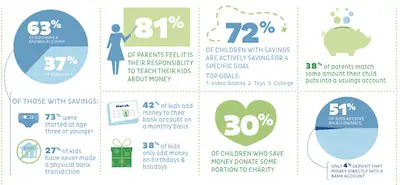You know it’s important to teach your child about money — so why aren’t you? A recent study reveals much about the state of savings for kids today, and what we as parents can do to make it better.

Research shows that an overwhelming 81 percent of parents feel it is their responsibility to teach their kids about money and savings, yet only 63 percent of parents stated their children had a savings account, and only 27 percent actually indicated that they take their children into a physical bank to make an account transaction at least once a month.
This data, derived from a national survey of more than 2,000 U.S. parents conducted by DoughMain, a free financial education and family organization website, aimed to reveal how kids are interacting with money in their everyday lives. There was a clear need for tools to educate children about financial literacy, and a disconnect between what parents believe is their responsibility and what they actually take on.
The Consumer Federation of America and American Savings Education Council also released research in February that shows Americans are still struggling to save, that savings habits have slowed down in the U.S. overall, and that families are not actively creating savings goals.
DoughMain’s study also revealed that:
• 63 percent of kids 18 and under have savings accounts, and 73 percent of those savings accounts were started before the age of three.
• 43 percent of parents review bank statements with their kids monthly.
• 51 percent of parents give their children allowance, but only 4 percent require them to deposit that money into a bank account.
• Only 28 percent of children have used online banking to view their savings account balance.
• For children without savings accounts, their money is most frequently saved in a piggy bank, bonds/CDs, or checking accounts.
• Only 38 percent of parents are matching their children’s savings.
• Only 30 percent of children give some of their savings regularly to charity
“We want to see 100 percent of American children saving wisely, and from this survey, we can see that’s clearly not happening,” says Ken Damato, president and chief executive officer of DoughMain. “This research exposes that while parents want to be the primary finance teachers to their children, they’re just not doing it to the degree that’s going to make a real difference for the next generation.” Damato continued, “Things as basic as opening a savings account or how to read a bank statement are just not being taught in the classroom, leaving parents to be the primary educators about finances.”
Damato emphasizes that parents should actively teach financial education on a daily basis at home by creating “teachable moments” to avoid a future generation of financially illiterate adults.
Top 5 Tips for Teaching Your Child about Saving
1. Open a savings account for your child.
2. Take children to the bank to see how deposits work.
3. Help kids set savings goals and/or create family savings plans.
4. Start a family match program.
5. Use allowance as a learning tool.
Bank On These: Sites to Help Teach Financial Literacy
DoughMain.com
• has games and tools that encourage learning about finances through interactive play, making the process fun and engaging
• offers a bank integration feature that enables users to import actual bank accounts and easily view balances, bringing the topic of savings to the forefront by putting kids in closer proximity to their savings goals and helping them watch their money grow
• provides an online chore chart tied to allowance/rewards program to teach kids about the fundamentals of money management in a relevant, digital way for today’s generation
JumpStart.org
• showcases the Federal Deposit Insurance Corporation’s free Money Smart for Young Adults curriculum, which helps instructors teach youth ages 12-20 the basics of personal finance, including role-model exercises (one allows students to shop for a credit card); each module consists of a fully scripted instructor guide, participant guide, and overheads
DoughMain’s survey was conducted by Touchstone Research between February 6–13, 2012 in conjunction with America Saves Week, which is coordinated by America Saves and the American Savings Education Council.
















